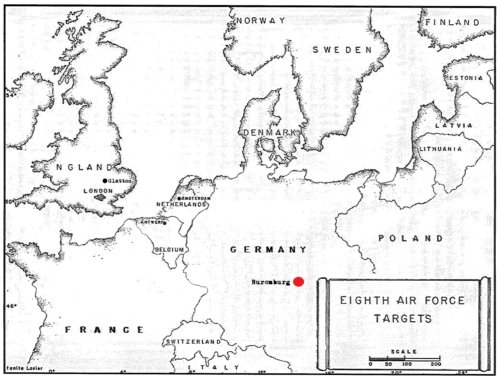TARGET: RAILROAD STATION
NUREMBERG, GERMANY
20 FEBRUARY, 1945

The Group went to Nuremberg (later to be the site of post war trials) for the city’s first time as a primary target. The Group comprised the 94th C Combat Wing with Major Maguire as Air Commander. The railroad station house was the assigned target. Goods and equipment were being moved through this area to the Eastern and Western Fronts.
Assembly with Wing and Division was without incident, except that forming over the Glatton Buncher Beacon, because of contrails and clouds, was 6,500 feet above briefed altitude. In Division formation, the Group had difficulty with clouds, haze and contrails. The low squadron became separated from the Group and flew the route to the IP alongside the 401st Bomb Group. Later, a squadron from the 303rd Bomb Group, which had also become separated because of weather conditions, joined the lead and high squadrons of the 457th Group. Slight deviations in course were necessary in order to remain in Division formation. The Group came across the IP on course.
Cloud coverage at the target area was ten tenths and it was necessary to bomb in group formation, with the 303rd’s squadron taking the position of the low squadron. The 457th low squadron made an individual run on the target, bombing from 24,600 feet.
Bombing by lead and low box leads was accomplished by means of PFF equipment. No difficulties were encountered. The low squadron joined a group which the leader was unable to identify, but believed to be the 303rd Bomb Group. The other two squadrons, together with the 303rd squadron, flew in group formation behind the 40 1st Bomb Group. Return route was flown approximately as briefed and the Group landed without incident. Flak was moderate, however, no damage was done to the bombers.
A message was received later from General Doolittle, praising the results of the mission. Photographs indicated the attacks were successful to a very high degree. The message was as follows:
“Strike a/lack vertical and PRU photos indicate that visual and instrument attacks on Nuremburg 20 February, were successful to very high degree. The persistence and determination shown by 1st and 3rd Air Divisions in penetrating to the target through dangerous and hazardous weather is to be highly commended and the excellent and skillful use of instruments in placing patterns squarely upon the vital targets in the city is an indication of a high quality of training and expert coordination among members of lead crews. This target is of highest priority in our attacks’ against German rail and military supply movements and Thesday attack will pay a tremendous dividend in throttling and choking the German war machine. All crews and ground personnel instrumental in carrying out this attack are to be highly commended for their work.”
